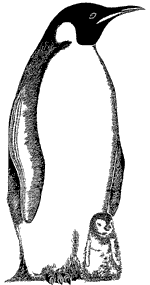|
At the heart of this GEMS guide are inquiries
into the shape, behavior, and life style of the emperor penguin.
Measurement and number activities also figure prominently in the
sessions. Any books that deal with the life styles of animals,
how and what they eat, and how they make a home for themselves
would make excellent connections. There does not seem to be much
fiction about penguins available for younger students. In addition,
some of the books selected have penguins doing fantastic things
that no real penguin would do. For instance, in Penguin Small
the penguin hero flies and goes all over the world. But children
love to hear about these amazing adventures and invariably they
comment that no real penguin could do those things. That’s
a great response!
Antarctica
Little Penguin
Mr. Popper’s Penguins
Out on the Ice in the Middle of the Bay
Penguin Small
Pinkie Leaves Home
Antarctica
by Helen Cowcher
Scholastic, New York. 1990
Grades: Preschool–1
Although this is a nonfiction book, it is an exciting and
dramatic tale about emperor penguins and contemporary life in
Antarctica. The story neatly dovetails with all the ideas in the
drama in Activity 2 and extends them by introducing other animals
that live on and around the icy continent. The impact people have
on the animals and the habitat of Antarctica is also presented.
The text and large, colorful illustrations provide a resource
for first graders who compare the Arctic and Antarctic regions
as well as the nesting behaviors of the Adélie and emperor
penguins.
Return to title list.
Little Penguin
by Patrick Benson
Philomel Books, New York. 1990
Grades: Preschool–1
Little Penguin is the story of Pip, an Adélie penguin,
who wants to be as big as an emperor penguin. As Pip playfully
explores the snow, ice, and water of her Antarctic home, she wonders
why some animals are big and some small. This story ties in beautifully
with the activities on relative sizes in Penguins And Their Young.
The children can use the illustrations to compare the appearance
of Adélie penguins with emperor penguins.
Return to title list.
Mr. Popper’s Penguins
by Richard and Florence Atwater
Little, Brown & Co., Boston. 1938
Grades: K–6
This well-loved classic about Mr. Popper’s experiences
with a house full of curious Adélie penguins delights children
who are old enough for a book with small black and white drawings.
Relevant chapters include Chapter IV: Captain Cook, in which the
penguin Captain Cook eats Mr. Popper’s goldfish, and Chapter
VII: Captain Cook Builds A Nest, in which he collects marbles,
a half-eaten lollipop, and other miscellaneous objects resembling
stones to build a nest in the refrigerator. At one point Mr. Popper
dresses up like a penguin and struts around the house. The nesting
behavior of these Adélie penguins provides a wonderful
contrast to the emperor penguin, which does not build a nest.
Return to title list.
Out on the Ice in the Middle of the Bay
by Peter Cumming
Annick Press, Toronto. 1993
Grades: Preschool–2
The little girl Leah wanders away from home and encounters
a baby polar bear whose mother is close by. Leah’s father
plans to shoot the mother bear to save his child and the mother
bear prepares to destroy the man to defend her cub. This suspenseful
story gives children a view of Eskimo life in a contemporary Arctic
setting, and the beautiful ending provides an alternative to violence
in people’s encroachment on nature. Although this book does
not deal with penguins, first graders who compare the Arctic and
Antarctic regions in “Extensions for First Graders”
under Activity 2 should find this story especially relevant.
Return to title list.
Penguin Small
by Mick Inkpen
Harcourt, Brace, Jovanovich, San Diego. 1992
Grades: Preschool–1
This beautifully illustrated story about a penguin’s
journey from the North Pole to the South Pole provides many opportunities
for young children to contrast some of the things the fictional
Penguin Small does to what real penguins do. Read the story to
the children after they learn about real penguin behaviors and
habitats in Activities 1 and 2. Since Penguin Small’s behavior
and encounters are so fantastic, children enjoy the comparison.
Return to title list.
Pinkie Leaves Home
by Peter O’Donnell
Scholastic, New York. 1991
Grades: Preschool–1
Pinkie the Penguin, who lost all his feathers in an oil slick,
does not like cold weather. One day he sets off to find a warm
place by the sea where there is no ice and snow. This adventure
story reinforces the concepts that feathers keep penguins warm,
penguins eat fish, and penguins live by the sea. The story’s
surprise ending supports the idea that wearing a hat, scarf, and
coat is another way of staying warm. This book provides an amusing
extension to Activity 2, where the children learn about penguin
feathers.
Return to title list.
|
|

